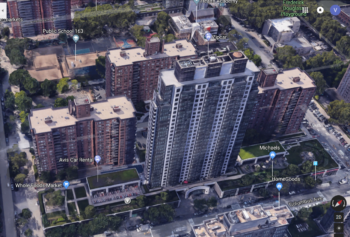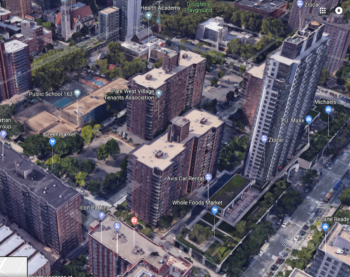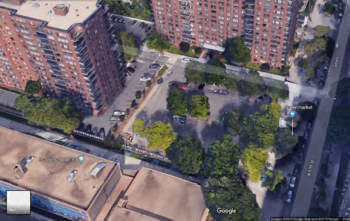
Park West Village superblock on the Upper West Side of Manhattan. (808 Columbus Ave, center). Image Credit: Google Maps.
Appellate Division finds that Buildings improperly issued construction permit for nursing home after misinterpreting the zoning resolution. Park West Village is a complex located on a superblock bounded by West 100th Street to the north, West 97th Street to the south, Columbus Avenue to the east, and Amsterdam Avenue to the west on the Upper West Side of Manhattan. The complex was built in the 1950s and 1960s as part of a federally subsidized middle-income urban renewal project, and includes residential buildings, a parking lot, a school, a church, a public library, a health center, and commercial buildings. Three original 16-story residential buildings remain on the eastern portion of the superblock at 784, 788, and 792 Columbus Avenue. The Park West Village buildings all exist on the same zoning lot.
Park West Village is zoned as part of a residential zoning district that has mandatory open space requirements. To construct taller buildings in such districts, usually a high percentage of the zoning lot has to remain as open space. Open space is defined by the zoning resolution as “that part of a zoning lot, including courts or yards, which is open and unobstructed from its lowest level to the sky and is accessible and usable by all persons occupying a dwelling unit or a rooming unit on the zoning lot.”
In 2007, PWV Acquisition LLC, the owner of Park West Village, was granted a construction permit by the Department of Buildings to build a new 29-story residential tower with two one-story attached wings to be used for commercial establishments on the same zoning lot at 808 Columbus Avenue. The new building was completed with a 42,000 square foot roof garden that is accessible to the residents of the tower, to the exclusion of the residents of the existing three Park West Village residential buildings, even though they share the same zoning lot. Residents of the new tower do, however, have access to all of the open areas on the remaining zoning lot, such as the courtyard areas, in addition to their rooftop garden.
Prior to the new building’s completion, residents of the original three residential buildings brought a suit challenging the new building.

View of Park West Village superblock from the corner of Columbus Avenue and West 97th Street, Upper West Side, Manhattan. Image Credit: Google Maps.
The residents argued that since they could not access the roof garden on the new building, the garden did not qualify as “open space”. If the garden does not qualify as open space, the new tower could not be completed because it would be in violation of the zoning rules.
The Department of Buildings disagreed with the residents. Buildings interpreted the zoning law as requiring a building-by-building calculation when determining the amount of open space needed. Buildings’ decision was based on finding that the definition of open space did not specify that when, as in this case, the zoning lot has multiple buildings, open space must be a common, centralized space that is shared by all occupants of the zoning lot.
On appeal, the Board of Standards and Appeals agreed with Buildings. The residents then brought an article 78 petition challenging the Board’s decision, but ultimately settled in 2009 and the new 29-story building at 808 Columbus Avenue was constructed with the roof garden.
In 2011, the City Council amended sections of the zoning resolution affecting the open space requirement to clarify that for zoning lots with multiple buildings, open space must be space that is accessible to all residents of any residential building on the zoning lot and not only the building that contains the open space in question.
The amendments also made clear that for a rooftop space of a building on such zonings lots to qualify as open space, it must be accessible and usable by all residents on the zoning lot and not just by the residents of that building.

Image of parking lot at 125 West 97th Street, Manhattan. Image Credit: Google Maps.
Subsequent to the adoption of these amendments, Jewish Home Lifecare, Inc. (JHL) entered into an agreement to purchase the Park West Village parking lot, located at 125 West 97th Street, for the development of a 20-story nursing home. The new building would require approximately 20,000 square feet of open space. Residents again opposed as an additional building would bring the zoning lot into non-compliance with the open space requirements
In determining that there was enough open space to allow the new building, JHL included in their calculations the exclusive 42,000 square foot roof garden at 808 Columbus Avenue as well as the new, and accessible by all residents, 10,000 square foot rooftop garden that their proposed nursing home would have.
Buildings and the Board of Standards and Appeals again decided against the residents finding that despite the 2011 amendments, in the case of a multi-building zoning lot, the open space definition could be read to allow some open space to be reserved for the residents of a single building, as long as the residents of each building have access to at least the amount of open space they would have access to if the buildings were on separate lots.
Residents then brought an article 78 petition, arguing that JHL could not include in its open space calculation the exclusive 42,000 roofed garden. The residents argued that even if the garden qualified as open space under the 2009 definition, it does not qualify as open space under the amended definition. Without the inclusion of the garden, no excess open space exists that would permit the addition of the nursing home. Therefore, the construction permit should be revoked. The supreme court declined to hear the case and the residents appealed.
The Appellate Division held that the language of the zoning resolution as to open space requirements was “clear and unambiguous,” requiring that open space be accessible to all residents of any residential building on the zoning lot, not only the building containing the open space in question. Given that Buildings’ and Board of Standards and Appeals’ use of the building-by-building formula in calculating JHL’s building open space ratio was contrary to the zoning resolution, the construction permit issued by Buildings for the nursing home should be revoked.
In re Peyton, 166 A.D.3d 120, 86 N.Y.S.3d 439 (1st Dep’t 2018).
By: Viktoriya Gray (Viktoriya is the CityLaw Fellow and New York Law School Graduate, Class of 2018).


As the attorney for petitioners in this case, I’m delighted that you wrote this otherwise accurate account of it, but permit me two small quibbles.
Prior to 2011, the Zoning Resolution provided that the calculation of the AMOUNT of open space required was to be done on building-by-building basis, DOB and BSA found that this was inconsistent with the requirement that the open space be “accessible to, and usable by,” all residents of the zoning lot, and that therefore there was an ambiguity, which they resolved in favor of the owner/developer. However, there never was any ambiguity, because the manner in which the required AMOUNT of open space was to be calculated had nothing to do with who could ACCESS and USE that open space. Moreover, the manner of doing the calculation — whether building-by-building or for the zoning lot as a whole — did not even affect the result of the calculation! In 2011, the City Planning Commission and the City Counsel passed hundreds of amendments to the Zoning Resolution, known collectively as the “Key Text Amendments.” Among the amendments was the deletion of two words, which made clear that the calculation of the required open space was to be done for the lot as a whole. This amendment was not actually a change, but only a clarification, and the accompanying report of the City Planning Commission so described it.
The Supreme Court did not decline to hear the case: it affirmed the BSA’s decision in favor of the owners/developers, who argued, illogically, that because the 2011 Amendments had not changed the definition of “open space,” their prior decisions were still valid.